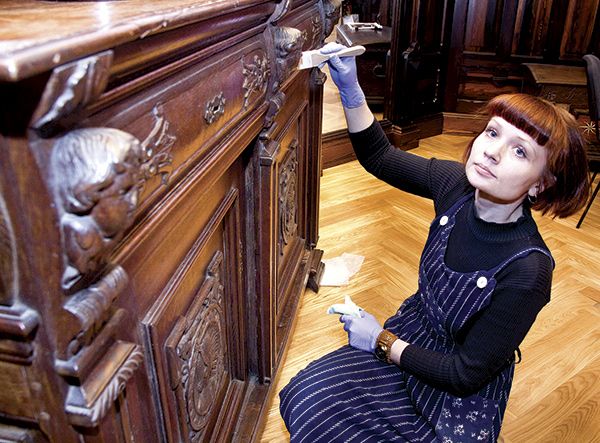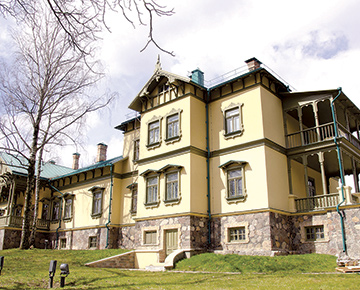
Restoration of the estate, which once belonged to the Prushinsky and Lyubansky families, has taken six years. In the 1920s, it was home to academician Vavilov and, a century earlier, to Dunin-Marcinkiewicz. Work began in 2008, though plans were initiated in 2002, by Minsk City Executive Committee: entitled ‘On the Restoration and Development of Loshitsa Estate and Park Complex in Minsk’.
The Deputy Director of Minsk’s History Museum, Piotr Khotko, tells us that it was very difficult for restorers and designers to come to a unified decision, delaying work with contractors. He notes, “Now, thank God, everything is over. The experts have completely restored the original shape of the estate, with lost features recreated in modern materials. The estate is living once more, which is the important thing. We hope that everyone visiting the halls may be filled with the spirit of the 19th century.”

Fine art restorer Marianna Zhitkevich
In fact, the architectural elements, fragments of picturesque decor, mouldings and ornamentally tiled stoves and fireplace look like new. The impression is deceptive: all the stoves are authentic and each is a work of art. They would work for their intended purpose if needed but are not lit, on safety grounds.
Restoring the interiors has taken several years, since war and time had not spared the floors, windows or ceilings. Some fragments have been left as they were, so that the work undertaken can be appreciated, as Mr. Khotko explains. He shows us a wall in the lobby, saying, “We intentionally left this part, to show the colour in which it was painted at the end of the 19th century. It faded over time, but was once bright terracotta. Experts used scalpels to scrupulously clear each millimetre of paint, peeling back many layers: sometimes, up to ten.”

Loshitsa’s first mansion was built at the end of the 16th century and early 17th: information remains on its external and internal appearance. Early 19th century construction is on display in one of the rooms, accompanied by a ‘tree’ of all the owners, from Vasily Tolochinsky onwards. Mr. Khotko indicates two portraits, saying, “These are Yevstafy and Yadviga Lyubanskie: the last owners of the estate. During Lyubansky’s time, the house both blossomed and declined. Being a strong host, he transformed the estate into a vivacious residence but, after death of his wife, gave up housekeeping and, in 1913, left Loshitsa for good.”
The present ‘host’, the Director of Minsk’s History Museum, Galina Ladisova, hopes that the site will become a calling card for 19th century Minsk life. She comments, “The city has acquired a new historical corner. We’ve achieved our main goal of preserving the estate for present and future generations. We’re running individual tours, in addition to taking groups. There’s no need to worry that the place will become too noisy once visitors are more regular: it will retain its romantic atmosphere.”

Hasten to See
A Magnolia Kobus is currently blooming in Loshitsa’s park: the very tree brought from Japan by Yevstafy Lyubansky, for his wife Yadviga. The tree is located just behind the house and, according to legend, blossoms each year on the day of Yadviga’s birth. Amateur botanists are sure to enjoy seeing the delicate elegance of this wonderful plant, which blooms only briefly.
By Yuliana Leonovich











